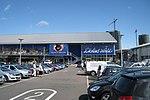Tower Hill to Cockham Wood
Forests and woodlands of KentGeological Conservation Review sitesSites of Special Scientific Interest in Kent

Tower Hill to Cockham Wood is a 47.8-hectare (118-acre) biological and geological Site of Special Scientific Interest on the northern outskirts of Rochester in Kent. It contains two Geological Conservation Review sites.This site contains typical woodland on Tertiary deposits, and sandy areas which have diverse invertebrates, including seven nationally rare bees and wasps. Upnor Quarry exposes a complete sequence of Tertiary rocks.There are public footpaths through the site, but some parts are private land.
Excerpt from the Wikipedia article Tower Hill to Cockham Wood (License: CC BY-SA 3.0, Authors, Images).Tower Hill to Cockham Wood
Upnor Road,
Geographical coordinates (GPS) Address Nearby Places Show on map
Geographical coordinates (GPS)
| Latitude | Longitude |
|---|---|
| N 51.41 ° | E 0.531 ° |
Address
Upnor Road
ME2 4UP , Frindsbury Extra
England, United Kingdom
Open on Google Maps











